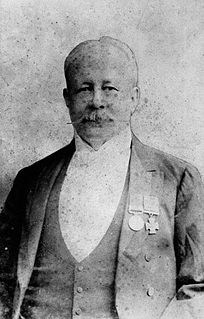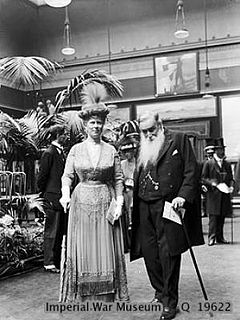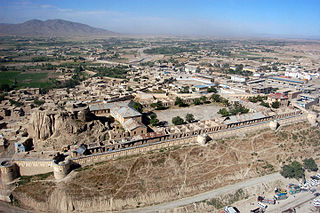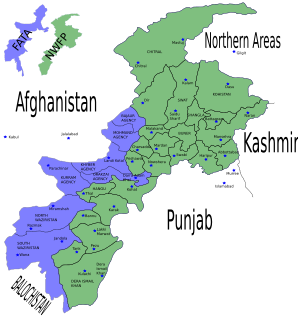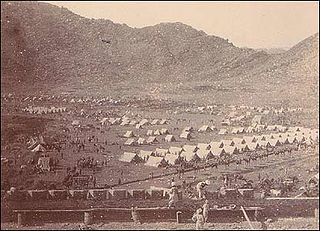| Ambela Expedition | |||||||
|---|---|---|---|---|---|---|---|
| |||||||
| Belligerents | |||||||
| Afghan Pashtuns Yusufzai tribes | |||||||
| Commanders and leaders | |||||||
| Neville Bowles Chamberlain | Saidu Baba | ||||||
| Strength | |||||||
| 6,000 men | 15,000 men | ||||||
| Casualties and losses | |||||||
| 238 killed 670 wounded [1] | |||||||
The Ambela Campaign (also called Umbeyla; Umbeylah; Ambeyla) in 1863 was one of many expeditions in the border area between the Emirate of Afghanistan and the Punjab Province of British India (this area was formally renamed to North-West Frontier Province in 1901, present-day Khyber Pakhtunkhwa); this campaign was against local Pashtuns of Yusufzai tribes of the border region between British India and Afghanistan.

The Emirate of Afghanistan was an emirate between Central Asia and South Asia, which is now today's Islamic Republic of Afghanistan. The emirate emerged from the Durrani Empire, when Dost Mohammed Khan, the founder of the Barakzai dynasty in Kabul, prevailed. The history of the Emirate was dominated by 'the Great Game' between the Russian Empire and the United Kingdom for supremacy in Central Asia. This period was characterized by the expansion of European colonial interests in South Asia. The Emirate of Afghanistan continued the war with the Sikh Empire, which led to the invasion of Afghanistan by British-led Indian forces who did not accomplish their war objectives. However, during the Second Anglo-Afghan War, the British again fought against the Afghans and this time the British took control of Afghanistan's foreign affairs until Emir Amanullah Khan regained them after the Anglo-Afghan Treaty of 1919 was signed following the Third Anglo-Afghan War.

Punjab, also spelled Panjab, was a province of British India. Most of the Punjab region was annexed by the East India Company in 1849, and was one of the last areas of the Indian subcontinent to fall under British control. In 1858, the Punjab, along with the rest of British India, came under the direct rule of the British crown. The province comprised five administrative divisions, Delhi, Jullundur, Lahore, Multan and Rawalpindi and a number of princely states. In 1947, the partition of India led to the province being divided into East Punjab and West Punjab, in the newly created Union of India and Dominion of Pakistan respectively.

Khyber Pakhtunkhwa is one of the four administrative provinces of Pakistan, located in the northwestern region of the country along the international border with Afghanistan. It was previously known as the North-West Frontier Province (NWFP) until 2010 when the name was changed to Khyber Pakhtunkhwa by the 18th Amendment to Pakistan's Constitution, and is known colloquially by various other names. Khyber Pakhtunkhwa is the third-largest province of Pakistan by the size of both population and economy, though it is geographically the smallest of four. Within Pakistan, Khyber Pakhtunkhwa shares a border with Punjab, Balochistan, Azad Kashmir, Gilgit-Baltistan, and Islamabad. It comprises 10.5% of Pakistan's economy, and is home to 17.9% of Pakistan's total population, with the majority of the province's inhabitants being Pashtuns. The province is the site of the ancient kingdom Gandhara, including the ruins of its capital Pushkalavati near modern-day Charsadda. Originally a stronghold of Buddhism, the history of the region was characterized by frequent invasions under various Empires due to its geographical proximity to the Khyber Pass.
Contents
The local Pashtuns were vehemently opposed to British colonial rule and frequently attacked British forces. In 1858, an expedition led by Sir Sydney Cotton drove the Pashtuns from their base. By 1863, however, they had regrouped around the mountain outpost of Malka. A force led by Neville Bowles Chamberlain planned to destroy Malka. They set up an operational base in the Chamla Valley accessed by the Ambela Pass, but they were soon bogged down a numerically superior local force. Reinforcements drafted in by the local Commander-in-Chief eventually broke through the pass, received the surrender of the Bunerwals and went on to burn Malka. The expedition saw 1,000 British casualties and an unknown number of Indian casualties.
Lieutenant-General Sir Sydney John Cotton was a British Army officer.

Field Marshal Sir Neville Bowles Chamberlain was a distinguished British military officer in British India. He served in the Bengal Army and saw action in the First Anglo-Afghan War, Gwalior Campaign, Second Anglo-Sikh War, Indian Rebellion and Second Anglo-Afghan War. He later became Commander-in-chief of the Madras Army.


